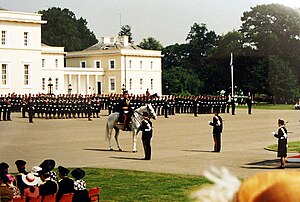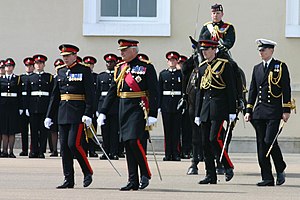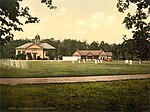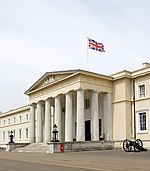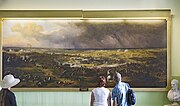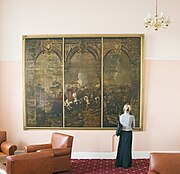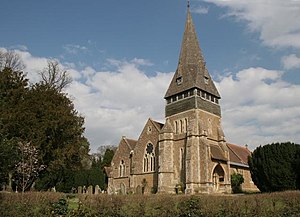Sandhurst, Berkshire
| Sandhurst | |
| Berkshire | |
|---|---|
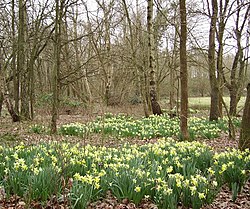 Daffodills in Ambarrow Court | |
| Location | |
| Grid reference: | SU836618 |
| Location: | 51°20’56"N, 0°48’0"W |
| Data | |
| Population: | 20,803 (2001) |
| Post town: | Sandhurst |
| Postcode: | GU47 |
| Dialling code: | 01344, 01276, 01252 |
| Local Government | |
| Council: | Bracknell Forest |
| Parliamentary constituency: |
Bracknell |
Sandhurst is a small town in Berkshire, a place of some 8,000 homes and 21,000 inhabitants, primarily a residential village but with a few light industries. It is in the south-eastern corner of the county, close to the borders of Hampshire and Surrey, a little northwest of Camberley in the latter county.
Sandhurst is known worldwide as the location of the Royal Military Academy Sandhurst (often referred to simply as Sandhurst). Despite its close proximity to Camberley, Sandhurst is also home to a large and well-known out-of-town mercantile development, named "The Meadows".
The town is just off the A30 and close to junction 4 of the M3 motorway. These and frequent train services to London enable to it to takes its place as part of the London commuter belt.
Contents
Landscape
Sandhurst consists of four main districts, from west to east: Little Sandhurst, Sandhurst (central) and College Town, with Owlsmoor to the northeast. North of the town are Edgbarrow Woods and Wildmoor Heath. To the east is Broadmoor Bottom, an expanse of heathland together with fir tree plantations. This eventually backs onto the high-security Broadmoor Hospital.
Sandhurst is bordered, on the south, by the River Blackwater, and several of the Yateley Lakes along its course are within the parish, notably Trilakes with the "Trilakes Country Park". This is also the county boundary with Hampshire at Blackwater. The town of Crowthorne is to the north, the village of Finchampstead to the west, and Camberley, across the Surrey county boundary, is on its southeastern side. This is the closest sizeable town, though Sandhurst is also only 9½ miles south of the new town of Bracknell in Berkshire.
The soil is sandy, with a subsoil of sand and gravel.
The Royal Military Academy
The The Royal Military Academy Sandhurst commonly known simply as Sandhurst is the British Army officer initial training centre located adjacent to the village of Sandhurst. The Academy's stated aim is to be "the national centre of excellence for leadership."
All British Army officers are trained at Sandhurst, including late entry officers who were previously Warrant Officers, and the cadets include many from elsewhere in the world,. The Academy is the Army equivalent of the Britannia Royal Naval College in Dartmouth, the Royal Air Force College in Cranwell and the Commando Training Centre Royal Marines.
The Academy straddles the counties of Berks and Surrey, where the county border marked by a small stream known as the Wish Stream, after which the Academy journal is named. Primarily, the Academy is situated in College Town, a suburb of Sandhurst, and partly in the outer region of Camberley town. The nearest railway station is Blackwater in Hampshire.
History
In 1720 a Military Academy was established at Woolwich in Kent in to train cadets for commissions in the Royal Artillery, becoming the "Royal Military Academy" in 1841, though known to the cadets as "the Shop". In 1806, the Academy expanded its purview to train for the Royal Engineers and later Royal Signals cadets. In 1799, a school for staff officers was established at High Wycombe and in 1801 it became the Senior Department of the Royal Military College (RMC).[1]
Major-General John Gaspard Le Marchant devised the Royal Military College.[2] He opened the Junior Department of the College at West Street in Marlow[3] in 1802[4] to train "Gentleman Cadets" for the infantry, cavalry and Indian Army.[1] (Coincidentally, this was the same year as both Saint-Cyr[5] and West Point were founded by the French and Americans respectively.[6]) The Junior Department moved from Marlow in 1813, into the present buildings designed by James Wyatt at Sandhurst.[7] A few years later, the Junior Department was joined at Sandhurst from High Wycombe by the Senior Department, which in 1858 became a separate institution, the Staff College.[1]
On the outbreak of the Second World War, Sandhurst became the home of 161 Infantry Officer Cadet Training Unit (RMC), which moved to Mons Barracks, Aldershot in 1942; for the rest of the war Sandhurst was used as a Royal Armoured Corps Officer Cadet Training Unit (OCTU).[8]
The Royal Military Academy Sandhurst was formed in 1947 by the merging of the Royal Military Academy in Woolwich with the Royal Military College in Sandhurst, and the united institution came to the site of the latter.[9] When National Service ended and the Mons Officer Cadet School in Aldershot closed in 1972, the RMAS became the sole establishment for male initial officer training in the British Army.[10] In 1984, the Women's Officer Training College Bagshot moved to Sandhurst and in 1992 a new Commissioning Course unified the training of male, female and foreign cadets.[1]
The Royal Military Academy Sandhurst Collection shows the history of the Royal Military Academy, Woolwich, The Royal Military College and the Royal Military Academy, Sandhurst. The collection includes the Royal Military Academy's Gentlemen Cadet registers, historic archive, uniforms, paintings, photographs and other artefacts.[11]
For the 1948 Summer Olympics the Academy hosted the running part of the modern pentathlon]] competition.[12]
Training at Sandhurst was the subject of a three part television series, first broadcast by the BBC in October, 2011 (rebroadcast in April 2012).
Churches
Churches in Sandhurst include:
- Church of England:
- St Michael and All Angels in Little Sandhurst, (13th century, but was largely rebuilt in 1853)
- St George's in Owlsmoor, built as a wooden structure in 1960 and rebuilt in 1993
- Baptist: Sandhurst Baptist Church, built in 1884.
- Methodist: Sandhurst Methodist Church built as a Wesleyan Methodist chapel in 1906
- Roman Catholic: Church of the Immaculate Conception, built in 1959
History of the town
Saxon and Mediæval periods
The name Sandhurst is plain English: "sand woodland", which well described the area. In early 14th century records, Sandhurst appears as part of township of Sonning, a large minster parish spreading over much of eastern Berkshire, which later became a hundred when its villages obtained their own churches.[13] These lands belonged to the Bishops of Salisbury. There were two manors in Sandhurst: 'Hall' in the grounds of what is now the Royal Military Academy and 'Sandhurst' on the site of Sandhurst Lodge. Nothing remains of the original buildings.
Tudor to Georgian periods
In the early modern era, Sandhurst parish was a small farming community on the very edge of Windsor Forest, Sandhurst Walke being an important forest division subject to forest laws.[13] Locals had the right to cut turf, bracken, heather and wood that was primarily cultivated to feed the forest deer, kept for the hunt, Royal hunting parties had a hunting lodge in the vicinity of Hart's Leap Road.[13] A number of court records show how Sandhurst folk sometimes took more resources than was allowed them.
Farming has always remained a major part of village life here and some defunct farms are still remembered in the names of housing estates, roads and even a restaurant: Sandhurst Farm, Snaprails, Caves Farm, Ambarrow Farm, College Farm, Rectory Farm, Beech Farm and Rackstraws Farm. In the mid-16th century, William, Lord Sandys, the Lord Chancellor to King Henry VIII, owned a supposed manor called 'Buckhurst' in the area between College Town and Central Sandhurst.
Victorian Age and twentieth century
Life changed very little in Sandhurst until the 19th century when large sections of land were sold for the building of the Royal Military College, which moved from Marlow in 1812.[13]
The railway arrived in 1849 and a number of large country residences sprang up in the area: amongst them, Harts Leap, Forest End, St Helens Upland, The Warren, Longdown Lodge, Ryefield, Snaprails, and Ambarrow Court. Sandhurst Lodge was erected in about 1858 by Robert Gibson and leased to John Walter, of The Times Newspaper, and then Sir William Farrer, solicitor to Queen Victoria and The Duke of Wellington. Perry Hill and The Ceders came later. Only a few remain today. The others have been demolished and land developed.
Such large houses and institutions, including the Broadmoor Asylum for the Criminally Insane and Wellington College in nearby Crowthorne, led to a great expansion of the local population as people moved into the area looking for work. Further residential housing was erected for these workers, as well as more schools for their children, more places of worship and other community resources.
St. Michael's Church of England School, Little Sandhurst, was opened in 1862 and other schools followed in quick succession.
From the late 1950s to the 80s, large housing estates have been built creating the conglomerate town of today from the original four villages of College Town, Sandhurst (Central Sandhurst), Little Sandhurst and Owlsmoor.
Recreation and sport
The Sandhurst tug of war team have been three times World champions, as seen on sign posts entering the town.
- Cricket: Sandhurst Cricket Club
- Football: Sandhurst Town FC play at Bottom Meadow
- Sandhurst Joggers, founded in 1987
Sandhurst Recreation Park contains tennis and basketball courts, cricket and football pitches, playground (with large sand-play area) and a small skatepark. The Coffee Spot - a local public dining establishment - is in the vicinity. The park has a large balancing pond where a firework show is held once a year, usually on the closest Saturday to Guy Fawkes Night and the Sandhurst Donkey Derby - a community festival - is also an annual event.
Big Society
Sandhurst has an active Historical Society.
Outside links
References
- ↑ 1.0 1.1 1.2 1.3 Sovereign's Parade Programme. RMA Sandhurst. April 2012.
- ↑ Major-General John Gaspard Le Marchant (1766-1812) Defence Academy
- ↑ Marlow Tour Marlow Society
- ↑ "RMAS: The story of Sandhurst". http://www.army.mod.uk/training_education/training/17061.aspx. Retrieved 6 July 2009.
- ↑ "Ecoles Des Saint-Cyr". http://www.st-cyr.terre.defense.gouv.fr/index.php?ID=1010988. Retrieved 6 July 2009.
- ↑ Ambrose, Stephen (1966). Duty, Honor, Country. A History of West Point. Baltimore: Johns Hopkins University Press. ISBN 0-8018-6293-0., p.22
- ↑ Sandhurst - Royal Berkshire History
- ↑ Training Army
- ↑ Facilities in Sandhurst - 1937 A detailed description by a new recruit.
- ↑ "Mons Officer Cadet School". http://www.sandhurst.mod.uk/history/history9.htm. Retrieved 6 July 2009.
- ↑ "RMAS Archive". http://www.sandhurst.mod.uk/tour/archives.htm. Retrieved 29 June 2009.
- ↑ 1948 Summer Olympics official report. p. 47.
- ↑ 13.0 13.1 13.2 13.3 Ford, David Nash (2001). "History of Sandhurst, Berkshire". Royal Berkshire History. Nash Ford Publishing. http://www.berkshirehistory.com/villages/sandhurst.html. Retrieved 28 December 2010.
- PH Ditchfield (1923), The Victoria County History of Berkshire.
- Sandhurst Town Council - History Page
- Sandhurst Town Council - FAQ Page
